Introduction: Mary Harrell-Sesniak is a genealogist, author and editor with a strong technology background. In this guest blog post, Mary explains some of the unusual or archaic terms often found in historical newspapers, and provides examples from period newspapers.
When I first started searching historical newspapers to help with my family history research, certain terms that I found in old papers confused me.
In the beginning, I found myself wondering: what was a “relict” or a “consort,” and why were there so many references to “inst.” or “instant,” and “ult.” or “ultimo”? It took some time to sort all these terms out, and I found various genealogical dictionaries useful.
Knowing that some of you may be having the same confusion about this terminology, I’d like to share some examples and definitions of the more commonly-found terms in old newspapers, with some insight on genealogical clues that these terms may provide.
MEANINGS OF GENERAL NEWSPAPER TERMS
Communicated (often abbreviated Com.): When reading old newspapers, you may spot the word communicated or its abbreviation, com. It can occur at the beginning of an article, or more typically it will be abbreviated at the end of the article, and indicates that the item was written by someone other than a staff writer, and “communicated” to the newspaper for publication. A notice at the beginning of the newspaper article will often look like this:
Whenever you see the term communicated or its abbreviation com., look for additional articles in other newspapers. You never know if the first article you found is complete—often it has been edited from the original, and if you find that original article it may contain more family history information than the edited version of the article you found.
Here is an example where the abbreviation com. has been inserted at the end of the newspaper article. Note also that this example has a “Request to Insert,” explained next.
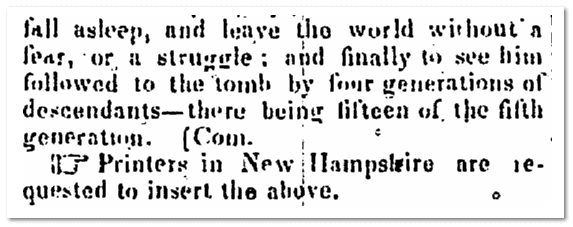
Requests to Insert: An often overlooked clue in old newspapers is a request for printers to republish a notice in other locations. Generally, this indicates that a person or family once resided elsewhere, or has a familial or business connection outside of the published location, and therefore readers in that additional location will have an interest in news about the individual or family. This is a great clue to steer your family history searches to locations you might not have considered otherwise.
Mastheads: Typically located at the top of the front page, the masthead is the printed matter consisting of the name of the newspaper, along with details of its publication (date, location, etc.).
Here is an example of a masthead from a New Hampshire newspaper:

When saving important proofs for genealogical purposes, it is advisable to review the masthead. You may also learn something interesting, such as that Isaac Hill, printer of the New-Hampshire Patriot & State Gazette, was also a publisher of the “Laws of the United States.”
DEFINITIONS OF RELATIONSHIP REFERENCE TERMS
Banns or Bans (or Publishing of the Banns): This is an ancient matrimonial term, originating from the Middle Ages. A Banns proclamation was typically published on three consecutive Sundays prior to a wedding. The requirement was abolished by the Roman Catholic Church in 1983, but is still used in some parts of the world. Original Banns certificates are rare, but you may be able to locate a few in some archives.
In this 20th century newspaper notice, the entire announcement is about a couple’s wedding banns:

In this 19th century newspaper article, we see an amusing story about how important the banns requirement was:
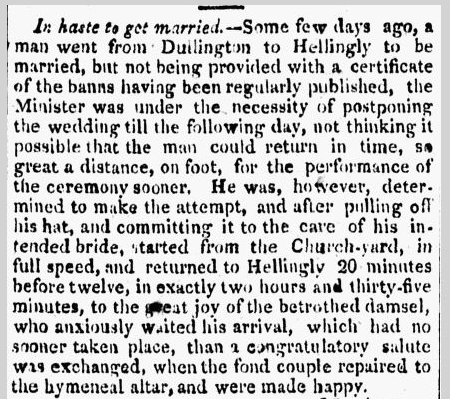
Because he had no proof the banns had been “regularly published” as required, the Minister postponed the wedding until the following day. However, the groom would not be deterred! He pulled off his hat, handed it to his bride-to-be, and took off running at “full speed.” He returned “in exactly two hours and thirty-five minutes, to the great joy of the betrothed damsel” with the requisite proof that the banns had indeed been published—whereupon the Minister performed the ceremony!
Consort: A consort is a partner, and in the case of a death, a female who leaves a surviving spouse. An easy way to remember the term consort is to think of a marriage as a “consortium” between a husband and wife. A corresponding term is relict (see the next entry), along with spinster or bachelor, for persons who remain single.
In this example from an 1802 newspaper announcing Eleanor Harris’s death, she is described as the “consort” of Thomas Harris. Note the representation of the “s” as an “f,” common in 18th and early 19th century newspapers, so that “consort” actually reads “confort.” Also note that her death date is reported as “the 8th instant” (again, with the “s” spelled with an “f” so that it actually reads “inftant”). I’ll explain what “instant” means shortly.
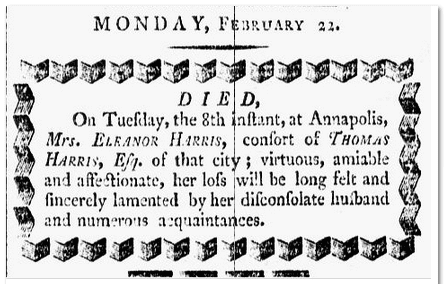
Relict (relictus): Relictus is a Latin term meaning having inherited or been bequeathed. Ergo, the relict is the survivor (usually a widow) of the marriage union.
The first sentence of this 1907 newspaper article reads: “Mrs. Prudence Hale, relict of the late Marshall Hale, died early yesterday morning at the home of her son…” It is lamentable that the typesetter misspelled her late husband’s name as Marshall “Hall” in the headline.
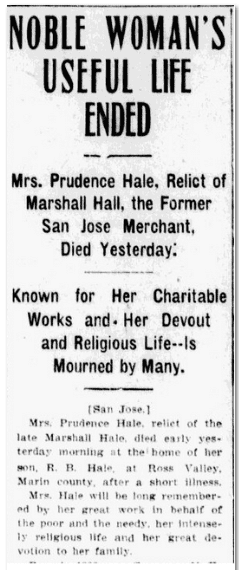
DEFINITONS OF TIME FRAME TERMS IN NEWSPAPERS
Rather than print a specific date, old newspapers sometimes refer to a date by using terms such as instant, proximo and ultimo. Occasionally they do this for religious reasons, which I’ll explain shortly.
Instant (often abbreviated inst.): This term refers to a recent occurrence in the present or current month. In the consort example above, Eleanor Harris’s death date is reported as “the 8th instant.” Since her death notice was published on 22 February 1802, this means she died on 8 February 1802.
Proximo (often abbreviated prox.): Proximo refers to something that will occur in the future, or next month, as seen in this advertisement for the British armed ship Louisa, which was scheduled to sail on the “20th proximo.” Since this announcement was published on 27 February 1800, this means the Louisa will sail on 20 March 1800.
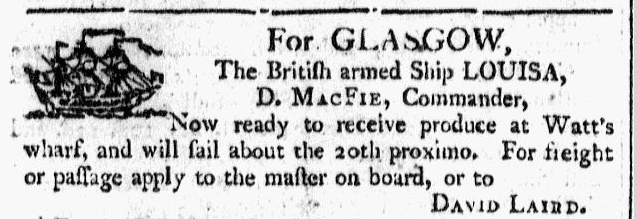
Ultimo (often abbreviated ult.): Ultimo or Ultimo Mense is a Latin term/phrase that refers to an occurrence from last month.
For example, in one old newspaper death notice Lt. Elliott’s death was specified as December 6, and in another (published in January), his death was reported as having occurred on “the 6th ult,” which is another way of saying December 6.
Boston Courier (Boston, Massachusetts), 23 December 1841, page 4:
- “DIED, In Chester, N. H. Dec 6, Lieut Jacob Elliott, 86, a soldier of the revolution.”
Bellows Falls Gazette (Bellows Falls, Vermont), 10 January 1842, page 3:
- “In Chester, N. H. very suddenly on the 6th ult. Lieut. Jacob Elliott, 86…”
Whenever you find an “ultimo” reference, cross-reference the date with vital records, since the newspaper in this case is reporting on an event that happened the previous month and is not immediate. Reports were often reprinted from one paper to another, and after sufficient time had passed the original date may have become unclear. In addition, some historical newspapers occasionally used the “ultimo” reference to refer to an event from two months prior.
In this notice from 1842, one’s first inclination is to record Mr. Basset’s death as having occurred in December of 1841, since the death notice was published in January and referred to the “23d ult.” However, upon further examination, I’ve uncovered some citations that report his death as having occurred in November.

I suggest you consider recording “ultimo” dates as approximations (died circa or about).
New and Old Style References for Dates (often abbreviated N.S. and O.S.): Another reason that dates in historical newspaper notices may not be specific pertains to beliefs held by various religions, such as the Society of Friends, aka Quakers.
Since the commonly-used names for months are based upon pagan Gods (e.g., January from Janus, February from Februus, etc.), the early Quakers deemed it sacrilegious to use such names. Instead, the Quakers referred to months by the order in which they appeared during the year.
In this example from a 1788 newspaper, the time of the yearly meeting is recorded as being “from the 12th [Day] of the fifth Month, 1788, to the 19th Day of the same inclusive.”
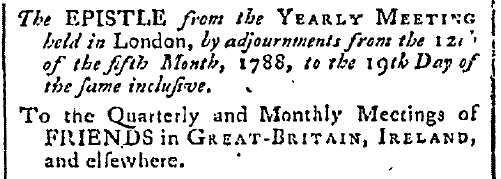
The conversion for Quaker dates is complicated, so if you find it necessary to record one, seek out a calendar converter and undertake further research. Mistakes are all too common.
Prior to 1752 (when the American colonies adopted the Gregorian calendar), the first month of the year was not January; the year started with the Spring Equinox in the middle of March.
The reason the calendar changed (from the Julian to the Gregorian system) was to accommodate for leap years. After several centuries the equinoxes were not falling on the calendar at the proper time, so various days were removed and the first of the year became January 1. When it was necessary to explain an old or new style date, an abbreviation of N.S. or O.S. was added.
In this 1822 newspaper article, both dating systems are used to give John Stark’s birth date: “Aug. 28, 1728, old style, corresponding to Aug. 17, N.S.”
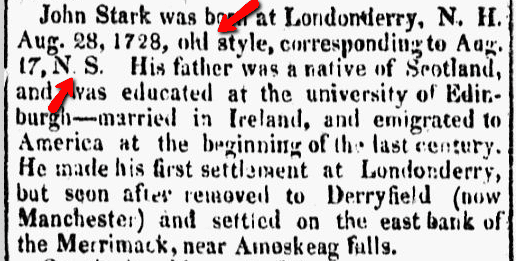
You may wish to consult one of my early RootsWeb Review articles, “Dates and Calendars through the Ages,” located at http://ftp.rootsweb.ancestry.com/pub/review/2007/0606.txt
You may also find it helpful to read “Quaker Dating before 1752” at the Swarthmore Friends Historical Library Website at www.swarthmore.edu/academics/friends-historical-library/quaker-meeting-records/quaker-calendar.xml.
I hope these definitions and genealogy tips helped you gain a better understanding of the newspaper terminology often found in old newspapers. Have you discovered any perplexing newspaper terms in your genealogy research? Share them with us in the comments!


Regarding the “long S,” which superficially resembles an “f,” the letters are distinguishable, as the cross bar extends to both sides on an “f,” but only to the left on the long S. It is likewise distinguishable in handwriting as a figure 8, with the lower loop written clockwise, whereas an “f” would have a counterclockwise lower loop.
Thanks for this helpful tip, Steve!
As Chairman of the Plainfield Township Historical Commission, we are always looking for speakers to keep our community and others informed and encouraged to tell their story. Your research findings would certainly add a sense of humor and interest to others. Do you do presentations and what might be the particulars of having you present your work at a community event?
Thank you
Jerry
You have confused masthead with flag.
http://en.wikipedia.org/wiki/Masthead_%28publishing%29
is a list of the editors and publishing people who work at a paper.
The big name on the front page of a newspaper is called the “flag.”
former librarian at a journalism library
Very nice examples of terminology and how common terms change over time.
Thanks for sharing the information with genealogists and historians.
What is the relationship between the two people, which has been cited as: Male Person 1 is the “next relation” of Male Person 2 “
I’m sorry … I should have said (for the above) that they both are named John Hough.
What does (ne with a ‘ over the e, then another e James) mean? (ne’e James)
It means “originally called” or “born” (used especially in adding a woman’s maiden name after her married name).
For males né, for females, née. It’s French for “born.” In French adjectives agree in gender, as well as number. Since only females generally change their names at marriage in western cultures, you only see née in obituaries.
That’s French, I think. It means “born.” The word with one accented “e” (é) applies to males, and the word with an additional plain “e” applies to females.
I found just what I was looking for, plus a lot more. Thank you for your help in making it clear.
You’re welcome. Glad the article was useful.
In a newspaper list of people who died (https://www.ancestry.com/interactive/50015/40699_2221301230_7232-00192 – U.S., Newspaper Extractions from the Northeast, 1704-1930), there are either a T. or an A. after the death date and immediately before what I assume is the death date.
Marcy, Charles Henry d. July 27, 1897 (T. July 28)
Marcy, Capt., Daniel d. Nov.3, 1893 (T. Nov.3)
Marcy, John H. d. Oct.16,1879 (A. Oct.17)
What is the meaning of the T. and the A.?
Thank you!
Susan,
Thanks for writing. When you see abbreviations in published resources, look in the index or for notes provided by the author. I suspect these are not standard abbreviations, but ones chosen to indicate the sources or newspapers from which the data was extracted.
Mary
Mary
Does anyone know what M.A.P. might stand for at the end of Irish newspaper articles in 1901? Thanking you in advance if you do.
Question: What was the common definition of “spinster” in ships’ passenger lists? Were all females of age, single or married, listed as such in manifests?
Ada,
Than you for writing.
In general, spinster indicates an unmarried female, but it’s possible for a recording error to have occurred. Although rare, it’s possible that a passenger may have provided an incorrect status in the case of a divorce or after the death of a spouse.
Mary
The statement in an article of marriage says “on the 27th nlt.” What does the “nlt” mean? I know it is the 27th of the month but don’t get the “nlt.” It is on all the marriage listings. They are all short and to the point listing bride, her father, groom and pastor and where each is from.
Thanks,
Sheri
Sheri,
Thanks for your question. Without seeing the article, I can only guess that nlt was a typo for ult.
Mary
I have 2 obituaries from the newspaper in 1864. “On the 27th, nlt., in Newport”; On the 21st, nlt., in Juniata Twp.” What does NLT mean?
What does “prox.” mean in this notice: “Peter X, F. & B.; Rose Y, prox.”? It was a list of criminal trials. Also, what does F & B mean?
Hello, thank you for your research and this most helpful and interesting article. I have an abbreviation that I would like your help with. I believe I know what it means but I would like to know specifically what the letters stand for. The abbreviation is afsd. It is found in wills and testaments, as to how property is to be dispersed. Example: child. afsd., all personal estate. In event of death of any survivor or survivors to inherit deceased’s portion.
I tried to find an answer on Google and in the dictionary but so far no luck. Hope you can help. Thanks, Sandy
“afsd” is an abbreviation for “aforesaid,” which can relate to places, people, etc.
Darlene,
Thank you for answering Sandra Young’s query. I will add the meaning of afsd to my research.
Mary
Explain this one: “Col. Isaac Craton, late a member of this Lodge, departed this life on the morning of the 19th April, ultimo…” (14 May 1831, Sat).
If “ultimo” means last month, they already gave the month, so…..?
DAS,
Thank you.
This is a reminder of why one should look for confirmation of dates. It may be an example of a typographical error or they may not have expected to publish the report until later. Often publishers have space to fill.
Mary
What does the term “last” mean when it follows a day of the week? Specifically, I have an article in a newspaper published on Friday, 7 February 1919, that refers to an incident that occurred on “Friday last.”
In the phrase “Friday last,” last means the one immediately before, similar to our saying, “last Friday.”
At the bottom of a newspaper advertisement, there is often a brief code that describes how often it is to be published and for how long. Are the dates start dates or end dates? Here are some examples, with my guesses:
(a)May 2d, ’50 – pub. 14 Sep 1850; thus May 2, 1850 is clearly a start date.
(b) Sept. 13, 1854 tf – pub. 21 Nov 1854; again, Sept. 13, 1854 is clearly a start date, but what is “tf”?
(c) jan30 dtf – pub. 14 Mar 1851; presumably starting Jan 30, 1851, but what is “dtf”?
(d) july 15 – pub. 29 Jun 1844; referring to a traveling photographer’s short stay ending, so July 15 looks like an end date.
(e) jan28 2mos tw – pub. 27 Apr 1848; twice a week for two months, but it’s now three months later.
(f) nov10w – pub. 28 Apr 1854; weekly, but is Nov 10 the start date or the end date?
(g) nov11-sww-1y – pub. Jul through Oct 1854; semi-weekly and weekly, for 1 year, from Nov 11, 1853.
(h) je 29 – pub. 20 Nov 1853 to 12 Apr 1854; from 29 Jun 1853, or until 29 Jun 1854 start date unknown?
Thanks for your help.
Bernice
Bernice, although we don’t know the answers to all of the codes in the newspaper advertisement, after consulting with a few genealogists, we came up with the following:
b) tf means “till forbidden” or essentially to run the ad until told to stop.
c) We’re not sure what dtf means
(h) je 29 could be initials of the person requesting or authorizing the ad, rather than June 29. There were various meanings to the codes.
(e) It could have been that the request to publish was extended, but they didn’t change the typesetting at that point. Or it could have come from a different publication, so they are doing 2 months from when they received it.
In reading the obituary of my great aunt written in 1924, it states her mother, who was widowed at a young age, moved to town with her five young children — but 5 years later she was “called away,” leaving the eldest daughter who was 16 to take care of the younger children. I can’t find any trace of what happened to her. So my question is: what might “called away” mean?
I agree that she probably passed away, but it may also be that she was placed in an institution. Reasons varied, from actual mental illness to the unfortunate placement of women in institutions for other reasons. Network with the historical society to see if they have any guidance on researching institutional records.
Just guessing here, Sarah, but perhaps she died — “passed away,” “called away” — it could be the same thing.